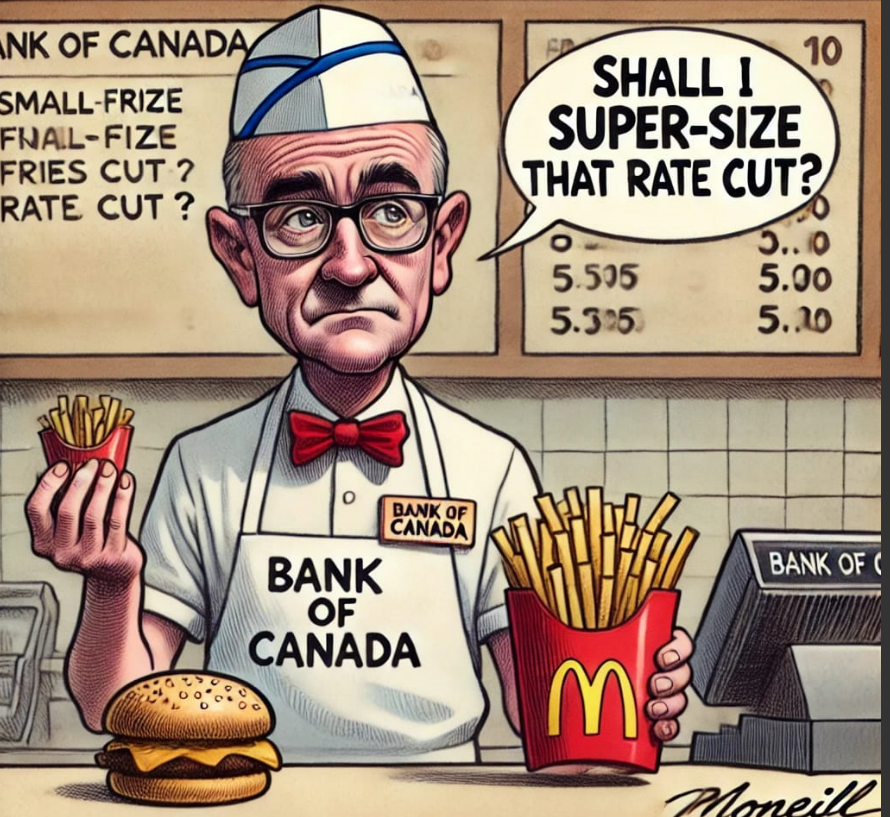
By Michael O’Neill
Canadian borrowers are smiling and chirping “Ba da ba ba ba, I’m lovin’ it.” And there isn’t a hamburger in sight. That’s because Bank of Canada Governor did what was expected and chopped the overnight rate to 4.25%, from 4.5%. It was the third consecutive rate cut since June—a notably aggressive move, especially considering Fed Chair Jerome Powell hasn’t even made it to the starting line.
Governor Tiff Macklem appears to believe that he has tamed the inflation beast and claimed that there is little evidence of broad based price pressures. He was also impressed with Canada’s economic growth saying that economy grew by about 2.0% in the first half of 2024 calling it a healthy rebound from the near zero-growth in the last half of 2023.
Reality Distortion
But let’s be real—it wasn’t a healthy rebound. Most of that growth came from government spending (1.5%) to pay public sector employees more. Wage increases in sectors like healthcare, social assistance, and education were particularly notable, with retroactive payments tied to arbitration decisions further boosting wage growth. Without the wage jump, the economy likely grew at just 0.6%. Public sector pay raises are hardly the same as government investments in productivity, infrastructure, or innovation. Instead, they inflate costs without driving real economic progress.

Work Harder Today For a Better Tomorrow (if you can find a job
The BoC is concerned that the labor market is showing signs of softening, with the unemployment rate rising to 6.4% in June and July. The Bank notes that the rise is concentrated among youth and newcomers to Canada, who are facing difficulties in finding employment. Furthermore, although business layoffs remain moderate, weak hiring activity suggests labor market slack is building. The combination of weak hiring and rising unemployment poses a downside risk to consumer spending and broader economic momentum.
The Rate-Cut Circus Comes to Town

The Bank of Canada statement and Tiff Macklem’s press conference left no doubt as to the direction of domestic rates and they even hinted at the possibility of being more aggressive if the labor market weakens sharply or if inflation drops too quickly and lingers below target. Canadian interest rates are headed lower with some bank economists predicting rates as low as 2.75% by mid-2025.
Power in Unity.
Far Fetched? Not likely, especially if Fed Chair Jerome Powell follows up on his Jackson Hole speech with a 25 bp rate cut and a dovish monetary policy statement that includes sharply lower projections in the Summary of Economic Projection. Mr Powell has turned his attention to the weakening US Labour market and the September 6 nonfarm payrolls report. If the US economy repeats July’s performance and only gains 114,000 jobs, calls for a 50 bp Fed rate cut on September 18 will be louder than Donald Trumps braying when he loses the November 5 election.
Squeezing the Loonie
That may not bode well for the Canadian dollar. At the moment, 10-year Canadian bonds enjoy a 75.1 bp advantage over the comparable 10-year US bond. The 2-year Canadian bond has a 59.9 bp advantage over its US counterpart. If the Fed catches rate cut fever and slashes US rates 75 bps by the November meeting, as many pundits predict, that yield advantage will shrink, without corresponding rate cuts by the BoC. If so, it could be lights out for the loonie.
On October 9, 2023, the CAD/US 10-year yield differential narrowed to 44 bps and USDCAD was probing 1.3890. History often repeats itself.
The Canadian economy is weak. There is a housing crisis, massive health care issues including long wait times, and disgruntled, over worked nurses and doctors who feel greatly underpaid. Youth unemployment is soaring, and Canada is still bringing in far too many immigrants and refugees than the economy can employ or house.
Self-Reliance is True Freedom.

The Trudeau government has made a concerted effort to destroy the fossil fuel industry to transition to a renewal energy economy without the infrastructure to support it and one lacking in cost-effective technology. Canada does not have sufficient rare earth minerals for large scale EV production or sustainable energy projects. That risks Canada’s entire renewable energy industry strategy being held hostage by foreign governments that are self-sufficient, like China. It happened before-google Arab Oil Embargo in 1973.
You may be loving the rate cuts but they may be masking super-sized economic problems ahead.





